THE SAMURAI OF THE SEA
When pirates operated in Japan's Seto Inland Sea around 500 years ago, the largest group, the Murakami Kaizoku, certainly did not fit the conventional image of pirates. They actually protected shipping rather than attacking it. They also had a refined sense of culture and assimilated foreign influences. In this program, broadcaster Peter Barakan meets people who have historical links to, or who have studied, the Murakami Kaizoku, to find out what these unusual pirates were really like.
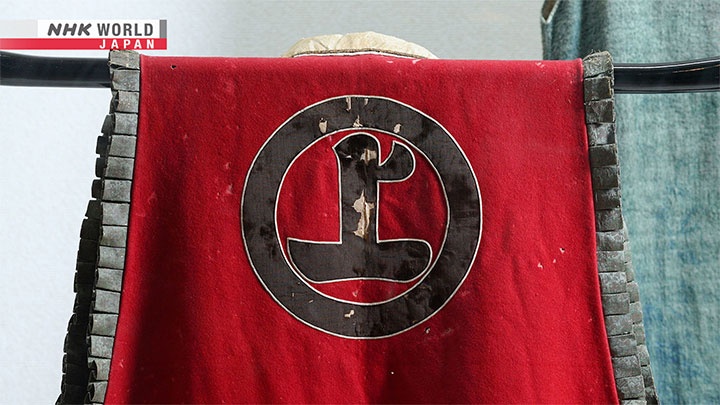
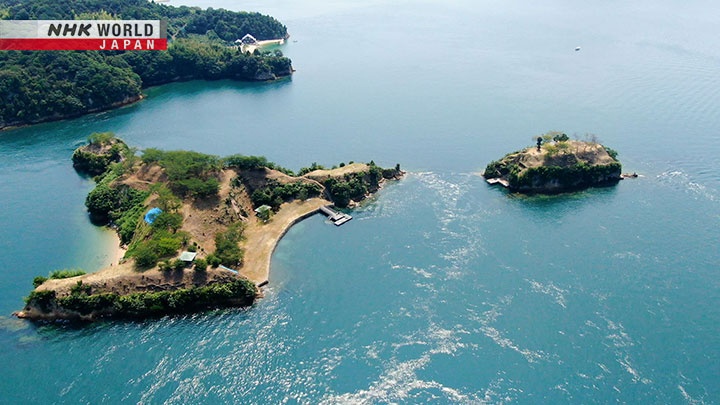
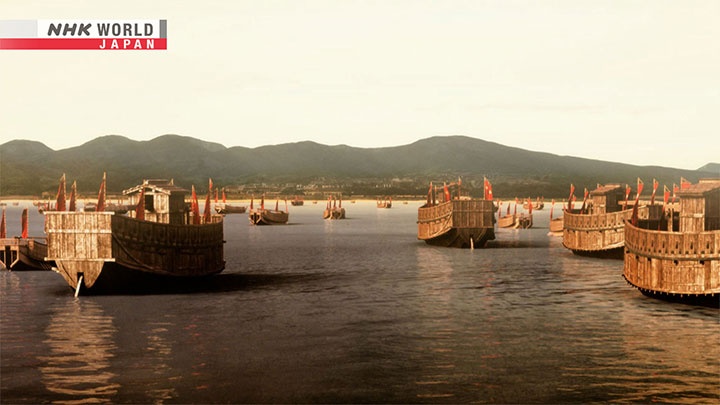
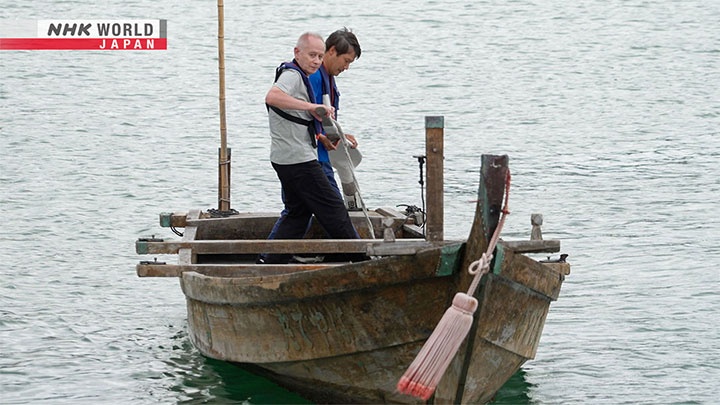
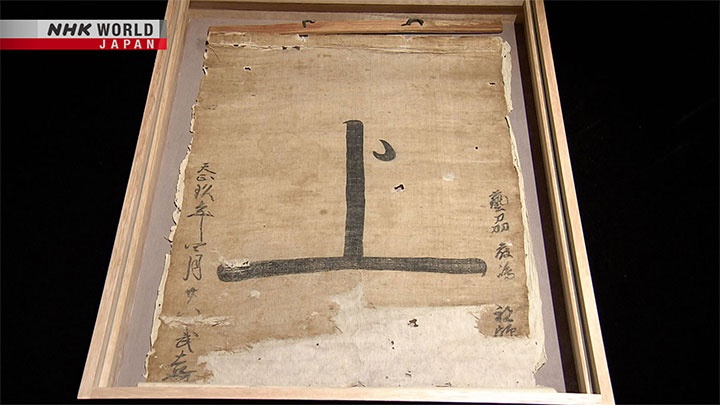
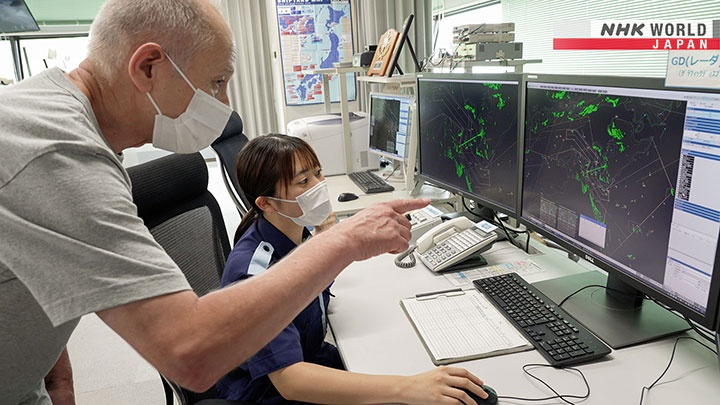
Transcript
The Shimanami Kaido is a scenic road linking some of the many islands in the Seto Inland Sea.
It has its own cycle path, one of the top cycling routes in the world.
And the views are breathtaking.
The whole route is around 60 kilometers long.
Its ten bridges span in many islands.
The Seto Inland Sea was once home to many "kaizoku," a word generally translated as "pirates."
In the 16th century, the Age of Exploration, the kaizoku were described by a Portuguese missionary, Luis Fróis.
He reported on what he called Japan's largest group of pirates, who had built a castle on an island.
He was referring to the Murakami Kaizoku, an armed force that held sway in the Seto Inland Sea
at a time when warlords were competing fiercely for territory and power.
The Japanese word "kaizoku" is normally translated as "pirate."
I think most of us have a mental image of pirates, which is derived from popular culture.
If you're my generation, or close to it, you may be thinking of Robert Newton playing Long John Silver in Treasure Island.
If you're a bit younger, it could be Johnny Depp as Jack Sparrow.
For most Japanese people, the same thing actually applies.
I didn't even know that Japan had pirates, but they did.
And a group called the Murakami Kaizoku controlled this area about 500 years ago.
It may not be fair to call them pirates; it seems that they weren't an out-an-out bad lot.
Our mission for this program is to discover just what the Murakami Kaizoku were.
We started by visiting places where the Murakami once lived.
We met people descended from them, and spoke to experts on the subject.
What we learned makes you wonder if these kaizoku should be regarded as pirates at all.
Far from wreaking havoc as lawless buccaneers,
it seems the Murakami Kaizoku worked hard to protect people in the areas they controlled.
Hello, Tanaka-san.
- Hello.
- Nice to meet you.
On behalf of the Murakami
Kaizoku Museum, welcome.
Our guide will be Tanaka Ken, the museum's curator, and a leading expert on the Murakami Kaizoku.
We begin with a boat trip to an important location.
Whereabouts did these kaizoku live?
Do you see that island ahead?
With a flat area on top?
That was the site of Noshima Castle,
one of their operational bases.
That's a castle?
Well, it's the remains of a castle.
Noshima has a perimeter of just 800 meters.
And there's an even smaller island right next to it.
In the 14th to 16th centuries, a period of violent turmoil in Japan, the Murakami controlled these two islands.
Looks dangerous!
The current really quite strong around here, isn't it?
Yes. But it gets stronger. It can
flow up to twice as fast as this.
So that would actually be quite dangerous.
Absolutely, yes. These days,
boats are equipped with engines.
400 years ago, they didn't have that luxury.
The waters of the Seto Inland Sea are mostly quite calm.
But near Noshima, where the water has to squeeze through narrow channels, the current is often very strong.
And around the island are many submerged rocks, making it extra difficult to approach.
The strong current created
an effective moat.
It made Noshima Castle
very hard to attack.
The Murakami occupied the island for about 250 years, between the 14th and 16th centuries.
Today, it is uninhabited.
But back then, around 200 people are thought to have lived there.
Evidence of habitation, such as land development, is still visible.
It's just big enough for one person to walk up here.
Yes.
OK. We're actually quite a long way up, aren't we?
Yes. Previously, people believed that
the kaizoku didn't actually live here.
They thought the island was used as
a lookout point, and as a dock.
But excavations revealed that
kaizoku did indeed live here.
What sort of stuff was found when you started excavating?
We found the remains of many
buildings from that time.
We also discovered dishes used
when applying makeup.
Also, pieces of pottery that appear to
have been used in children's games.
So there's evidence that
women and children lived here, too.
So it would have been whole families.
We believe so.
Here's an object that tells us about a custom practiced by the kaizoku.
Looks like the little saucers that people put soy sauce in.
It's a saucer, but not for soy sauce.
What do you think it's for?
I've no idea.
It's for drinking sake.
OK.
In Japanese, it's called "kawarake."
Never heard of that.
Warriors would drink sake to pray
for success on the battlefield.
It was a kind of ritual.
So it's for ceremonial use.
Yes. A saucer like this was used
just once, and then thrown away.
Ah.
Discarded kawarake were concentrated
in certain areas of the castle.
And the place with the most
was the central keep.
We found around 12,000
fragments of pottery there.
95% belonged to kawarake.
Drinking together might strengthen bonds,
or maybe they discussed strategy.
The keep was a special place.
Our next stop is where that central keep once stood, up on the highest part of the island.
It was here.
Ah.
OK. The castle keep and... a wonderful view.
All round, really.
From here, you can look out way across the Seto Inland Sea.
For the Murakami, this vantage point was essential.
They could observe all the vessels passing nearby.
Then, as now, the Seto Inland Sea saw a great deal of traffic.
The red lines show frequently used routes in the area between Kyushu, to the west, and Osaka, to the east.
The shortest route would often take vessels past Noshima.
That made the island a vital strategic location.
The Murakami Kaizoku also built castles at Kurushima and Innoshima,
allowing them to monitor almost every vessel moving through these waters.
How did the kaizoku-the pirates-ply their trade back in the 14th, 15th, 16th centuries?
They imposed a toll on all of the ships
passing through their territory.
That's how they made a living.
And did they resort to violent means to get people to pay?
They wouldn't attack without warning,
and hijack a vessel or seize its cargo.
First, they'd discuss the size of the toll
with a boat's captain. They'd negotiate.
If those negotiations broke down,
that's when the kaizoku would get tough.
Their bases operated like checkpoints.
And when the kaizoku got paid,
they didn't just let boats through.
They also guaranteed their safe passage.
It's a bit like the old American mafia movies where you pay protection money.
Well, the currents were
fast and treacherous.
This was a time of conflict, when
it was hard to know who to trust.
But your top priority would have been
to safely cross the Seto Inland Sea.
And so it was best to comply with
the kaizoku's rules. They kept you safe.
The kaizoku offered
protection in two ways.
One method involved a kaizoku member
boarding a boat personally.
They'd take it through to safety.
So like a pilot?
Yes, like a pilot.
The second method came later,
when sea traffic had increased.
Perhaps the kaizoku
didn't have enough pilots.
They handed out flags bearing their mark.
A ship flying that flag could move
safely through the checkpoints.
As long as you had permission,
you were able to travel safely.
That was another way
the Murakami Kaizoku did things.
They made a point of ensuring safe passage.
That, as we shall see, was an essential skill.
The Murakami Kaizoku emerged in the 14th century.
At first, they served as guards on cargo vessels.
Those boats transported salt that was produced in the Seto Inland Sea.
As the Murakamiknew the local waters extremely well,
they began to act as pilots for lords and merchants traveling by sea.
In the 16th century, they rose to new heights under the expert leadership of Murakami Takeyoshi.
Before long they were contolling nearly the entire Seto Inland Sea.
But why were they so knowledgeable about the local waters in the first place?
There's a clue on the beach at Noshima.
Have a look at this.
Pools of water, but intentionally made.
What are these?
These were for wooden poles.
They were used for mooring boats.
So they would tie their... tie their boats up to poles here in the rocks on... by the beach.
OK, that makes sense.
Just a couple of those.
Actually, around 400 of these
have been found on the island.
400? On a small island like this? That's a lot.
A regular part of the kaizoku lifestyle
was catching fish to eat.
They were fishermen?
Yes.
And of course, if they're plying their trade as fishermen in these waters, day in, day out, year after year,
they obviously know the waters probably better than anybody else,
which puts them in a very good position for guiding other people through here.
You're absolutely right.
They understood the tides, and could
estimate the depth of the water.
They knew the location of rocks
lurking just below the surface.
And that knowledge came in
very useful during times of conflict.
When acting as pilots, they shared
that expertise with their clients.
Know-how they accumulated while fishing
became the foundation of their business.
Back then, ships were the most important way to transport goods,
and guaranteeing their safe passage proved to be extremely lucrative.
It was an age of exploration, when different cultures spread through the world.
And the Murakami, too, were exposed to foreign influences.
Those influences are evident in a rare object in the museum.
Here it is.
It looks slightly different from the normal kind of clothing you see from Japan.
It's a battle surcoat, worn by
military leaders over their armor.
This character in a circle was
the crest of the Murakami Kaizoku.
We did some research into the dye
used to produce the red color.
It was made using an insect
called a cochineal.
It's from a family of bugs
called "scale insects."
They were originally farmed
in Central and South America.
You find them on cactus plants.
Another detail is the decoration on the sleeves.
This style wasn't seen elsewhere in Japan at that time.
We don't know which country
this influence came from.
But some experts think
it's somewhere in Europe.
Interesting. Obviously, they were sufficiently influenced that it would change the style of clothing.
The Seto Inland Sea was the setting for
a flow of people, goods, and information.
The Murakami Kaizoku would have been
right on top of the latest developments.
They'd be in a great position to adopt
anything new that appealed to them.
Through their activities, the Murakami Kaizoku were in touch with the ruling elite and international trends.
They acquired a refined sense of culture.
There's evidence that they practiced the tea ceremony.
And flutes used in noh theater and old court music have also been discovered.
They appreciated the spiritual side of life, too.
To learn more, we're visiting a nearby shrine.
It's called Oyamazumi Shrine, and it's located in an area once controlled by the Murakami.
It has over 2,600 years of history, and the sacred tree in the center of the precinct is said to have stood here from the beginning.
Hello. Nice to meet you.
Good morning.
This is the chief priest.
So tell me a little bit about your shrine.
It's dedicated to the deity
Oyamazumi no Okami,
That deity is worshipped around
the country as a god of the mountains.
But here, we also worship
the same deity as a god of the sea.
The Murakami clan themselves
would have worshipped this deity.
Oyamazumi no Okami has another role as a deity of warfare.
In the past, warriors presented weapons and armor to the shrine, as offerings.
One of those weapons, called a "naginata," is thought to have belonged to the Murakami.
This exhibit draws attention to the clan's cultural sensibilities.
It's a type of linked verse.
Linked verse was made collaboratively, and then dedicated to the deities.
A group of people would take turns to compose a couple of lines each.
This meant reflecting on the previous verse, and then adding something appropriate.
It was a sophisticated activity.
What kind of content is it? Is it religious in content?
They'd think up a theme that
seemed right on each occasion.
It wasn't just religious content.
The poetry wasn't created only
by Murakami Kaizoku leaders.
Ordinary local people took part too.
Those from all walks of life
composed poetry together.
So the whole society had a fairly highly evolved aesthetic sense.
The fact that they composed poetry
does point in that direction, yes.
On Yamato's Mount Katsuragi
the snow is piled as thick as dust.
The moon, now emerging,
shines down on the village below.
The clouds in the night sky will
scatter as the wind picks up.
The Murakami Kaizoku flourished in the 15th and 16th centuries - a time of near - constant fighting between regional warlords.
Feudal lords, impressed by their seamanship, saw them as "the samurai of the sea," and often sought their military support.
The boats that they generally used were small vessels like this.
We asked a local fisherman to show us how to pilot one.
OK, give it a go.
Let's get started.
At first, you have to build up
some momentum.
- You don't just use your arms.
- Right. Using your body conserves energy.
If you look ahead as you do this,
you can control the direction of the boat.
Push. Pull.
I'm exhausted!
Hard work, isn't it?
But it's a lot easier with two people.
It really is.
Doing it alone is so tiring.
I won't last five minutes on this.
It's really... it's not hard to do, but it's just really heavy.
Why did the Murakami Kaizoku choose to have boats like this?
I mean, you wouldn't think of something like this for fighting, would you?
The boats are maneuverable,
and actually quite quick, too.
So they're pretty good in a fight.
By skillfully piloting these small boats, they could freely change formation,
allowing them to engage even with battleships.
A historic battle in the late-16th century showcased the special skills of the Murakami Kaizoku.
Their foe was Oda Nobunaga, a warlord of great power and influence.
At the time, followers of a leading Buddhist sect were rebelling against Nobunaga.
His forces slaughtered monks and farmers who joined the movement.
He also attacked the head temple of the sect, near the sea in Osaka.
Working with another opponent of Nobunaga,
the Murakami helped to deliver food and other supplies to those besieged in the temple.
They provided an escort for the larger boats that were carrying the supplies.
In Osaka Bay, at the mouth of a river leading up to the temple,
they encountered the full might of Nobunaga's navy.
The museum has a valuable picture showing the circumstances of the battle.
This is an illustration of the battle.
It shows that Nobunaga's navy and
the Murakami Kaizoku fought in Osaka Bay.
We can see their boats
facing off against each other.
OK.
The boats facing this way are
the Murakami Kaizoku. They're labelled.
And guarding the shore
are Nobunaga's forces.
And who won?
The Murakami side. Overwhelmingly.
They made skillful use of their fast, maneuverable boats to achieve a decisive and dramatic victory.
Were they associated with any particular power group?
They might associate with one warlord,
but later distance themselves again.
They were relatively free.
Sometimes they were employed
as mercenaries.
They served as a professional
fighting unit, available for hire.
So they were basically businessmen.
It wasn't like they had a particular mission that they were trying to pursue.
Their mission and their business goals
weren't completely separate.
They pursued their business ventures
to look after family and community.
They wanted to protect the local area,
the place where they were born.
The novelist Wada Ryo is well versed in this period of Japanese history.
His work has helped to popularize the Murakami Kaizoku in modern times.
In 2014, his novel "Daughter of the Murakami Kaizoku" won a literary prize.
Until that point, the Murakami were relatively unknown, but the book made a huge impact.
It's an adventure story, starring the fictional Kyo, daughter of the kaizoku leader Takeyoshi.
Kyo put one foot up on the gunwale.
With a wicked grin, she stepped up
to her precarious vantage point.
"You think I'd let anyone else
do anything this thrilling?"
Her fearlessness brought cheers
from the other fighters on the boat.
The story of a woman boldly tackling daunting foes proved to be hugely popular.
The book sold over a million copies, and was adapted into a manga series.
People even visit the locations featured in the book.
What would you say is the biggest appeal of the Murakami Kaizoku for you?
This may sound silly, but I enjoy
the fact that they were pirates.
They had freedom. They were outlaws,
but they had common decency.
Basically, in troubled, lawless times,
they offered a certain sense of order.
I came to understand that they
were an integral part of society.
That was an interesting angle,
and so I investigated further.
You've made the central figure of the book a woman,
which is quite unusual for what is a very kind of macho society 500 years ago.
I wanted the main character to be female.
It's the opposite of what you imagine
when you hear the word "pirate."
But simply introducing a female
kaizoku would have been unconvincing.
Wada's approach is to conduct extensive historical research before embarking on writing.
On this occasion, the process of research, and then writing, took him over four years.
Searching through documents, he found evidence that Murakami Takeyoshi had a daughter - and she became the inspiration for Kyo.
I was reading about events
in the 15th and 16th centuries.
Whenever women were mentioned,
they had strong characters.
They were as rough and wild as the men.
They'd scold their husbands,
and order them off to battle.
I found it intriguing, and that's how
I came up with the character of Kyo.
It seems to be in many cases, the things that she does... she does out of a sense of...
I suppose "justice" is the word I'm looking for, maybe.
It's like she always... she does the right thing, to use a Spike Lee film title.
Well, I do think she bases her decisions
and actions on a sense of justice.
However, it's not the same as modern
thinking in Japan. She wants to fight.
That's who she is, and it shapes
her view of right and wrong.
Kyo's character presents an image of
justice that existed in those days.
And that's what I wanted to illustrate.
Do you think that era is particularly special one in the history of Japan?
I do think it's one of
the most notable eras, yes.
It really changed the way
Japanese people saw themselves.
That period had a distinct
formative power, I would say.
Back then, people had
a strong survival instinct.
They fought violently to protect their homes
in a way that is unthinkable today.
Of course, I'm not advocating for that lifestyle.
But the different perceptions
in the past and present are interesting.
It's an enjoyable contrast that
I wanted to share with my readers.
In the story, Kyo is confronted by the grim reality of war.
I never saw war as
anything other than glorious.
But I finally understand
how foolish I've been.
All the men going to war were just
doing their best to protect their clan.
I was fighting without
that fundamental commitment.
I was naive.
Wada's novel also illustrates the unique worldview of the Murakami Kaizoku.
If we let them tell us what to do,
we'll keep our homes, but lose our souls.
That wouldn't be a life worth living.
Kyo doesn't hesitate to join the fray, fighting for what she believes is right.
In that period, people didn't have... well, they just were starting to have guns, I suppose.
Mainly, they were fighting with bows and arrows and spears and swords.
And it's all very bloodthirsty, and people are chopping off people's heads and hands and stuff.
We have a totally different sense of values, I suppose, now.
But on the other hand, you look at the headlines in the newspapers, and there are wars going on everywhere.
And the way they kill people is different... people... but people are still getting killed all the time.
And I wonder if the value of a life has really changed very much.
It's difficult.
From a certain viewpoint,
it does seem that way, doesn't it?
Nuclear weapons exist.
We have weapons that can
kill vast numbers of people.
In some countries, maybe
thinking doesn't really change much.
It's only natural that people around
the world have different outlooks.
We may think, "Why are they doing that?"
Some behavior may seem inexplicable.
But we shouldn't really be surprised.
In the past, everyone was the same.
If you're familiar with history,
you stop seeing those people as monsters.
You start to understand. That's what
I think whenever I see war on the news.
In modern times, the Seto Inland Sea is a conduit for cargo vessels from around the world.
They often pass through the Kurushima Straits.
Five, six.
Up.
An electronic display flashes signals to passing vessels.
But who is sending the signals, and why?
Let's find out.
Hello.
Welcome! I'm head of this center.
I want to ask you about the sign board outside.
What's that all about?
It's a tidal current signal.
It communicates information about
the speed and direction of the current.
It shows whether it will
speed up or slow down.
This facility is known as Kurushima Martis.
It's run by the Japan Coast Guard, and shares information that helps cargo ships to navigate safely 24 hours a day.
Tayama Sakino has worked here for two years as a sea traffic controller.
Ships appear on this screen.
I can see if they're too close
to each other, or to an island.
So each of these triangles is a ship?
Yes. White dots and colored
triangles are ships.
The system estimates where a ship
will be in five minutes' time.
The controllers look for ways to keep ships clear of other vessels and rocks.
Key information about the speed and direction of the tidal current is shown on the tower display.
But even with the help of modern technology, the Kurushima Straits is challenging.
I'm wondering, 500 years ago, when the Murakami Kaizoku were active,
how did they go about guiding ships through here?
These days we have lighthouses,
and so on. Back then they didn't.
Piloting a boat through the strong currents,
while avoiding rocks, was difficult.
But the Murakami Kaizoku overcame
that with knowledge and skill.
I find that a very humbling thought.
In fact, the Kurushima Straits are so difficult to navigate that there's a special international rule here used nowhere else in the world.
The regular international rule is that vessels should stick to the right.
But here, vessels must sometimes keep to the right, and sometimes to the left,
depending on the direction of the current.
This rule is applied only in the Kurushima Straits.
On average, 500 vessels pass through each day.
The tidal flow changes every six hours or so, and the sea traffic changes sides accordingly.
The controllers shoulder a heavy responsibility.
Mis-time an instruction, and an accident may result.
The current is about to change direction, and so the controllers contact vessels entering the straits.
Information: Next tidal current is north going at 1430.
Instruction: shift to starboard side of the fairway, after passing Umashima Island.
Over.
OK. Going to starboard side fairway. Thank you!
And you have to go through this every six hours, right?
It's quite complicated, isn't it?
Yes, but we're keeping the sea safe.
We have inherited the role that
the Murakami Kaizoku once played.
Protecting the vessels passing through
is a big, historic responsibility.
We always keep that in mind
as we carry out our work.
In addition to Wada's novel about the Murakami, there's now a play on the same theme.
This is the Ōmorigumi theater troupe - all the cast and crew live locally.
For their debut play, they chose the Murakami Kaizoku for their theme.
The leader, Takeyoshi, is preparing for battle with the forces of Oda Nobunaga.
And we meet his son, Motoyoshi, commander of the kaizoku force.
We see Motoyoshi coming to terms with his role as a leader, no matter what it entails.
Actors were cast with no reference to gender.
But every one of them has a strong emotional attachment to the Murakami Kaizoku.
What did you find interesting or fascinating about the Murakami Kaizoku in the first place?
We hear about these famous
warlords in those days.
But sometimes their success rested on
working with the Murakami Kaizoku.
That isn't very well known.
They are so many unknowns,
and I find that very interesting.
When directing this play, I wanted to
show what bound the kaizoku together.
The Murakami Kaizoku, in particular,
had various strict rules.
A sense of unity is what gave
the Murakami clan their strength, I think.
The question is how we can make use
of that lesson in modern times.
Do any of you have any connection with the Murakami Kaizoku?
She's a direct descendant.
Sogabe Tomoko is actually descended from the kaizoku leader, Murakami Takeyoshi.
She plays a clan member who falls victim to a rule that seems disproportionately cruel.
When I was young, the Murakami Kaizoku
seemed to be embodied by my grandfather.
In World War II, he was a naval officer
on Iwo Jima. He died there.
It was the site of a terrible battle.
His remains were never returned.
That stuck with me.
As he was a naval officer, I saw
a link to the Murakami Kaizoku.
In order to protect people's lives,
the kaizoku gave their own lives.
That fact has always made me
think about the meaning of war.
Being involved in this play makes me
feel like I'm guided by my ancestors.
I love that.
In this scene, Takeyoshi hands down a verdict that would be unthinkable in times of peace.
Commander!
Father!
He got the password wrong.
Our rules are clear. He must die.
This organization is built on
order and discipline.
Do it.
Please, no! Forgive me!
Killing someone simply to maintain
the unity of a group is difficult to imagine.
They did live in extraordinary times.
But that kind of thing really happened.
That's what I think when I perform.
Sacrificing one person to protect the group raises questions about the sanctity - and the value - of the individual's life.
Wasn't there any other choice?
Rank-and-file fighters have
their lives and families, too.
A leader should make sure
that they stay safe.
I don't think I would have been able
to survive in that world!
The character I play, Motoyoshi,
is not wholly committed to the fight.
And that gives me an opportunity
to express my feelings about war.
I'm able to make use of that
in my performance.
Manabe Sadatomo,
leader of the Oda navy!
I, Murakami Motoyoshi,
have defeated you!
The play was a big success.
The cast were giving it their all.
I enjoyed it a lot.
I was really drawn into the story.
It was so moving.
As she performed, Sogabe found herself becoming unexpectedly emotional.
I wept. It was unlike anything
that ever happened in rehearsal.
I felt like my grandfather
was right there with me.
There's a historical link connecting
the Murakami Kaizoku to the present.
I wonder what they'd think if they knew
that their story is now a play.
I feel really proud, and excited about
what we might do in the future.
Globally, a lot of things
are really tough right now.
But the Murakami Kaizoku show us
the value of traditional community bonds.
I think their story and way of life have
something to tell us in the present day.
And I hope our play encourages
people to think about that.
As Japan's period of internal strife drew to a close,
the role of the Murakami Kaizoku changed, and they became fully integrated into a newly peaceful society.
I was a little surprised to see just how passionate so many people seem to be about the Murakami Kaizoku.
They've obviously succeeded in capturing people's imagination in this country.
Without doubt, a lot of that is due to the historical novel, and the comic derived from it.
Without wishing to over-romanticize the Murakami Kaizoku,
it's tempting to see in the heroic figure of "Kyo" a kind of moral compass
that perhaps Japan has a need for right now, given recent events in particular.
Everybody needs a hero a once in a while.